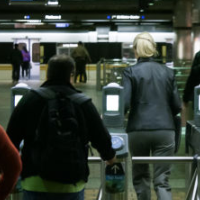After Two Decades, L.A. Recognizes that Subway Freeloaders Need Incentive to Pay
 Turnstiles at the 7th / Metro subway station (photo: Eric Richardson, Blogdowntown)
Turnstiles at the 7th / Metro subway station (photo: Eric Richardson, Blogdowntown)
There is apparently no honor in L.A., at least when it comes to riding the subway, so beginning this summer the honor system that allowed scofflaws to travel freely on the city’s rail system for decades is coming to an end.
Apparently it has come as somewhat of a surprise that early predictions by the Los Angeles County Metropolitan Transportation Authority (MTA) that 97% of rail users would voluntarily pay their $1.50 fares proved to be unrealistic. Trial runs last year using locked gates that required a paid fare for entrance reportedly raised between 18% and 22% more revenue.
Turnstiles are being installed, and those locations among Metro Rail’s 101 stations that already have them will turn them on, along with intercoms and cameras. Until now, riders without tickets could saunter through gates, if they existed, and hop on a train confident that chances were slim they would get caught. If caught, the ticket is $250, but anecdotal evidence is that few people pay them.
Metro Rail has been edging this way for a few years since its 1993 debut with just five stations and 4.5 miles of track. But early efforts to encourage ridership at all costs have given way to economic and human behavioral realities.
Unactivated turnstiles were installed at some locations in 2009 and test runs with activated gates began in 2011. The MTA’s decision in February to clamp down within six months made it official.
Zev Yaroslavsky, a longtime member of the Los Angeles County Board of Supervisors and MTA, estimated that making people pay to ride the train on just the Red Line alone would net an additional $4 million annually. Officials are trying to coordinate a ticketing system that will align the Red, Gold, Green, Purple and Blue rail lines with eight separate municipal bus lines and Metrolink to facilitate transferring from one system to another.
Installation of a workable turnstile system is estimated to cost $46 million and maintenance could run around $103,000 a month.
Not everyone is confident that the new, pay-as-you-go system will work. MTA board member Richard Katz told the New York Times, “I don’t think it will ever pencil out. It’s a huge sinkhole of money.”
Presumably, it won’t take two decades to find out if Katz is right.
–Ken Broder
To Learn More:
For Angelenos, End of the ‘Free’ Subway Ride (by Adam Nagourney, New York Times)
When Metro Locks Subway Gates, Riders Actually Pay to Ride (by Eve Bachrach, Curbed Los Angeles)
Metro's Free Ride May Soon be Over (by Jon Healey, Los Angeles Times opinion blog)
Metro Pushes Again for Lockdown on Fare Evaders (by Ari Bloomekatz, Los Angeles Times)
- Top Stories
- Controversies
- Where is the Money Going?
- California and the Nation
- Appointments and Resignations
- Unusual News
- Latest News
- California Forbids U.S. Immigration Agents from Pretending to be Police
- California Lawmakers Urged to Strip “Self-Dealing” Tax Board of Its Duties
- Big Oil’s Grip on California
- Santa Cruz Police See Homeland Security Betrayal in Use of Gang Roundup as Cover for Immigration Raid
- Oil Companies Face Deadline to Stop Polluting California Groundwater





